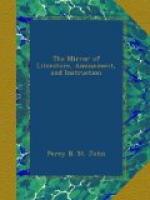“Fare well, your lovinge husbande,
“Tower of Londonne,
“STRAFFORDE.
“4th Feb. 1640.
“My Wife.”
* * * * *
STONE PILLARS AND CROSSES.
(For the Mirror.)
It appears from the accounts of the earliest historians, that single stones, or rude pillars were raised on various occasions, in the most remote ages. Of these we have frequent notices in the Old Testament, as of that raised by Jacob at Lug, afterwards named Bethel; a pillar was also raised by him at the grave of Rachel. The Gentiles set up pillars for idolatrous purposes. The Paphians worshipped their Venus under the form of a white pyramid, and the Brachmans the great God under the figure of a little column of stone. Many large stones are found at this day in Wales and Cornwall, which are supposed to have been raised by the Phoenicians and Grecians, who frequently resorted thither for tin and other metals.
In Ireland some of these large stones have crosses cut on them, supposed to have been sculptured by Christians, out of compliance with Druidical prejudices, that the converts from Paganism not easily diverted from their reverence for these stones, might pay them a kind of justifiable adoration, when thus appropriated to the use of Christian memorials, by the sign of the Cross. Some signs of adoration are at this day paid to such stones, in the Scottish Western Isles; they are called bowing stones. In the Isle of Barra there is one about seven feet high, and when the inhabitants come near, they take a religious turn round it, according with ancient Druidical custom.
Stones were raised also as memorials of civil contracts; as by Jacob, in his contract with Laban, when the attendants of the latter raised a heap, to signify their assent to the treaty. Those conical, pyramidal, and cylindric stones, perpendicularly raised, which are seen in the British Isles, were formerly introduced in general, to ascertain the boundaries of districts. On these, representations of the crucifixion were frequently cut, and the name of crosses were given to the boundary stones in general, though remaining without this symbol. Many instances might be given of these termini. At High Cross, on the intersection of the Watling Street and Foss Roman roads, there was formerly a pillar which marked the limits of Warwickshire and Leicestershire—the present column is of modern date; another distinguished the boundaries of Asfordby and Frisby, in the latter county. One at Crowland, in the county of Lincoln, the inscription on which has caused considerable dispute amongst antiquarians, has been much noticed. A famous one near Landoris, in Fifeshire, placed, as Camden says, as a boundary between the districts of Fife and Stathern, was also a place of sanctuary.




